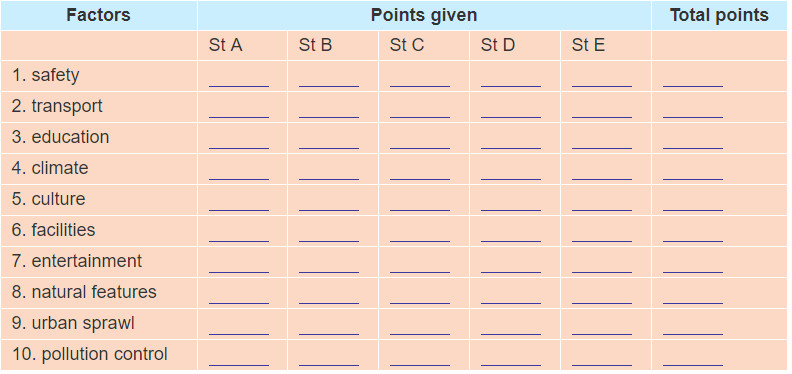Đừng bỏ lỡ những tính năng hấp dẫn của Baitap365.com
Unit 2: City Life - Cuộc sống thành thị
Skills 1 Unit 2 trang 22 SGK tiếng Anh 9 mới
Skills 2 Unit 2 trang 23 SGK tiếng Anh 9 mới Looking back Unit 2 trang 25 SGK tiếng Anh 9 mới Project Unit 2 Trang 25 SGK Tiếng Anh 9 mới Communication Unit 2 trang 21 SGK tiếng Anh 9 mới A Closer Look 2 Unit 2 trang 19 SGK tiếng Anh 9 mới A Closer Look 1 Unit 2 trang 18 SGK tiếng Anh 9 mới Getting Started Unit 2 trang 16 SGK tiếng Anh 9 mới Luyện tập từ vựng Unit 2 Tiếng Anh 9 mới Vocabulary - Phần từ vựng - Unit 2 tiếng Anh 9 mớiSkills 1 Unit 2 trang 22 SGK tiếng Anh 9 mới
Tổng hợp bài tập phần Skills 1 Trang 22 SGK Tiếng Anh 9 mới
Bài 1
Reading
Task 1. Work in pairs. What features are important to you in a city? Put the following in order 1-8 (1 is the most important).
(Làm việc theo cặp. Theo bạn đặc điểm nào quan trọng nhất ở 1 thành phố? Xếp theo thứ tự từ 1-8 ( 1 là cái quan trọng nhất.)
|
_____________ |
transport |
|
_____________ |
safety |
|
_____________ |
education |
|
_____________ |
cost of living |
|
_____________ |
climate |
|
_____________ |
entertainment |
|
_____________ |
culture |
|
_____________ |
convenvience |
Bài 2
Task 2. Read the passage quickly and find the information to fill the blanks.
(Đọc đoạn văn và tìm thông tin điền vào chỗ trống.)
1. The name of the organisation doing the survey:
2. The year of the survey:
3. The names of the best city and the worst cities:
Which is the best city in the world to live in? Every year, the Economist Intelligence Unit (EIU) conducts a fascinating survey to determine which cities around the world “provide the best or worst living conditions”. It uses factors such as climate, transport, education, safety, and recreational facilities in cities. It gives scores for each, and ranks the cities in order - from the best to the worst.
For the year 2014, the top 10 cities came from Australia, Canada, Europe, and New Zealand. Melbourne in Australia had the highest score, which means it is the most ‘liveable’ city. Some famous cities came in the top 20, such as Tokyo (19th) and Paris (17th). Perhaps surprisingly, Osaka (13th) had the best score in Asia.
Cities with major conflicts tended to score the lowest. In these countries, living conditions were the most difficult or dangerous. Among the worst cities on the list were Dhaka in Bangladesh, Tripoli in Libya, and Douala in Cameroon.
However, some other organisations _ individuals would like to add other factors to the index. They say that a city's green space urban sprawl, natural features, cultural attractions, convenience, and pollution should be added to the list.
Bài 3
Task 3. Read the passage again and answer questions.
(Đọc lại đoạn văn và trả lời câu hỏi.)
1. What factors are used by the EIU to rank the world's cities?
(EIU sử dụng các yếu tố nào để xếp hạng các thành phố trên thế giới?)
2. Where were some famous cities on the list?
(Danh sách nhiều thành phố nổi tiếng ở đâu?)
3. Why were Dhaka, Tripoli, and Douala ranked among the worst cities?
(Tại sao Dhaka, Tripoli và Douala lại nằm trong số những thành phố tồi tệ nhất?)
4. Which was the most "liveable" city in Asia?
(Thành phố nào "đáng sống" nhất ở châu Á?)
5. What are some factors that should be added to the index?
(Một số yếu tố cần được thêm vào chỉ mục là gì?)
Bài 4
Speaking
Task 4a. Work in groups of five or six. Conduct a survey to rank your own town/city or a town city you know. Give from 10 points (the best to 1 point (the worst) to each factor.
(Làm việc theo nhóm 5-6 người. Thực hiện một cuộc khảo sát để xếp loại thành phố của bạn hoặc 1 thành phố mà bạn biết. Tối đa là 10 điểm ( 1 điểm là thấp nhất với mỗi đặc điểm)
Ask each student in your group the question: "How many points do you give to factor 1 - safety? "
(Hỏi mỗi bạn trong nhóm câu hỏi " Bạn cho đặc điểm 1 bao nhiêu điểm?")
Then write the points in the table.
(Sau đó viết điểm vào bảng.)

b. Work out the final result of your group. Then present it to the class. Is your group's result the same or different from that of other groups?
(Tiến hành khảo sát rồi thuyết trình cho cả lớp cùng nghe. Kết quả của nhóm bạn giống hay khác các nhóm khác.)
Từ vựng
1.
2.
3.
4.
5.
Mẹo tìm đáp án nhanh
Search Google: "từ khóa + baitap365" Ví dụ: "Bài 5 trang 13 SGK Vật lí 12 baitap365